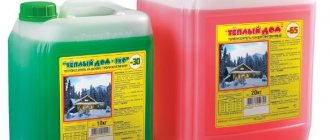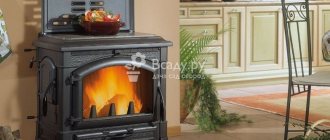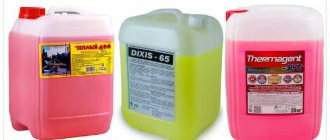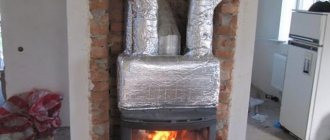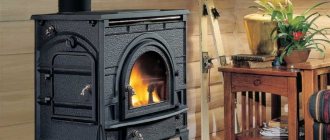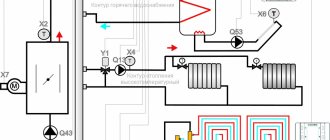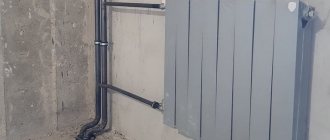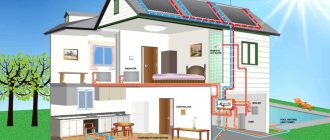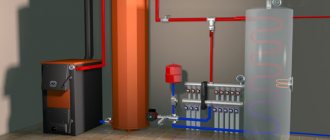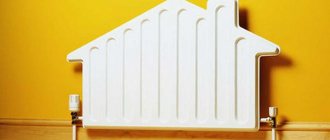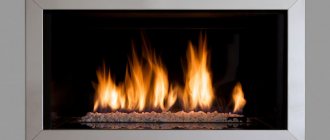Here you will learn:
- Types of heating
- Alternative heating for a cottage or private house
- Pros and cons of different types of coolants
- What is the most profitable heating system in a cottage?
- Comparison of costs of different heating systems
- One- and two-pipe heating systems
- Basic elements of a water heating system
- Which heating radiators to choose
- Installation of a cottage heating system
Regardless of whether an old system is being modernized or it is being designed from scratch in a newly built house, the first thing to start with is becoming familiar with the regulatory documentation. It describes in detail how the equipment is put into operation and describes the subtleties and features of its further use.
After spending some time on this, you can be sure that the heating system will last for many years. From year to year, the requirements are adjusted and updated. But there are some principles that every cottage owner should know. The first thing that needs to be ensured when installing a heating system is explosion and fire safety.
For safe operation during the installation process, you need to ensure free access to the equipment for cleaning and regular checks.
The list of rules that will help make a private home not only cozy, but also safe to live in, should include the following aspects:
- The temperature of open heating system elements should not be higher than that recommended by the manufacturer.
- Equipment and all appliances should be properly insulated. This will avoid burns, eliminate the formation of moisture and reduce heat loss. In addition, hot elements can ignite dust, gas or aerosol in the room.
- When using a coolant, the temperature of the latter must be 20 degrees Celsius lower than its evaporation or self-ignition temperature. For example, if the system uses water, then it must be prevented from boiling. An excellent solution would be to raise the pressure.
There are also operational requirements for the heating system. After all, any equipment must be as strong, durable, easy to operate, silent and easy to repair as possible.
It is better to order equipment from trusted manufacturers. Such companies produce truly high-quality products, since they stand behind them with their own name.
By choosing a boiler, radiators and pipes that best meet the listed criteria, you can save yourself from many problems.
Types of heating
There are two types of heating of country houses: autonomous and centralized heating. They are divided into several subspecies, operating on different energy sources:
- Natural gas.
- Liquid fuel – gasoline, diesel, diesel oil.
- Solid fuel - firewood, pellets, coal.
- Electricity.
- Natural sources of energy.
Each of them has its own set of advantages that are beneficial to use under certain conditions.
Heating equipment for a country house
Alternative heating for a cottage or private house
Heat pumps or solar collectors are most often used as alternative sources of thermal energy. The latter can also be a source of electricity. The cost of such equipment at the moment is astronomical and only owners of large, very large residential properties, where such investments will pay off in the foreseeable future, can afford them. In developed countries, governments actively subsidize the use of such equipment. Well, in the former USSR, the use of heat pumps and solar collectors turns out to be much more expensive than gas, coal and even electricity.
How can you heat a cottage?
Cottages, unlike multi-storey residential buildings, are not connected to a centralized heating system. After all, they are located outside the city. Therefore, for such an object it is necessary to create an autonomous type of heating. Many, when thinking about organizing heating for a country house, consider the option of creating a heating system with their own hands rather skeptically. And in vain. After all, equipping the system yourself is not so difficult. The main thing is to choose the appropriate type of heating and know some installation features.
It is advisable to decide on the heating option for the house at the stage of its construction. When calculating heating system parameters, many different factors are taken into account:
- building area;
- number of floors;
- used thermal insulation and building materials.
Every cottage owner wants heating to be comfortable and fuel consumption to be economical. Today, different types of heating of a country house are used: water, stove, gas, electric, etc. Each of them has its own characteristics, positive and negative aspects. Sometimes heat pumps or additional heating sources are used to optimize the operation of the heating system. Recently, solar collectors have been of great interest to homeowners.
Pros and cons of different types of coolants
Depending on the coolant, heating can be water, air, or electric. Some cottages are heated using open flames - fireplaces or stoves. Each type of coolant has its own advantages and disadvantages:
Water systems consist of a boiler, pipes and radiators. The cold coolant is heated in the boiler, then flows through pipes into radiators, where it gives off heat to the surrounding air. The cooled water is fed into the boiler and the cycle repeats again.
If the system is combined with underfloor heating, then the coolant flows from the radiators into the second circuit and only then returns to the heating device. The boiler itself can operate on gas, electricity, solid or liquid fuel.
Water heating with radiators
The principle of operation of the air system is simple: cold air enters the heat generator, from where it is supplied through air ducts to the rooms of the cottage. Warm flows displace cold ones, which also enter the heat generator, and the cycle repeats.
The air circulation mode can be natural or forced. In the first case, the heating in the cottage is disrupted if the windows or doors are open. And in the second you have to use electric fans.
To heat the cottage, you can use convectors, heaters or any type of electric heated floor (cable, carbon, etc.). These systems are the easiest to maintain because they are usually fully automated.
Scheme of air heating with a gas furnace
Electric heating of a cottage will cost much more than other types of heating. Another disadvantage: in the event of an accident, the house may be left without electricity and heating at the same time.
A stove or fireplace may be a good option for a small space, but it is unlikely to be suitable for a house with several rooms. In addition, you will have to give up the idea of organizing a convenient hot water system.
Autonomous heating of a private house
Pipe heating for cottages
System design: two main pipes that conduct heat are directed to the most remote points of the cottage. Thus, heating even the coldest cottage in winter conditions will last no more than 5 hours - this is the highest among all types of heating.
Single-pipe and two-pipe schemes are the perfect modern option for heating a cottage. The operating principle is surprisingly simple: air masses penetrate cold areas of the floor, heat it and then move to the pipes. This is repeated again and again, and thus the room becomes warm.
What is the most profitable heating system in a cottage?
If it is possible to connect to a gas main, this is an ideal option. Water heating in a cottage from a gas boiler was and remains the most profitable. It is best to use radiators as heating devices.
Warm floor in a cottage
An alternative to traditional batteries is water heated floors. However, in regions with harsh climates, underfloor heating alone will not be enough. You can choose a combined option: radiators and heated floors.
In the absence of gas, you have to choose which energy source is the cheapest. It can be electricity, solid or liquid fuel. When making calculations, they are guided by the area and number of floors of the cottage. The type of building materials and thermal insulation features are also important.
For a comfortable stay, you need to take care of the hot water supply. It often makes sense to connect a double-circuit boiler, which will provide both heating and the required volume of hot water.
Scheme of combined heating and hot water supply
Comparison of costs of different heating systems
Often, the choice of a specific heating system is based on the starting cost of the equipment and its subsequent installation. Based on this indicator, we obtain the following data:
- Electricity. Initial investments up to 20,000 rubles.
- Solid fuel. Purchasing equipment will require from 15 to 25 thousand rubles.
- Liquid fuel boilers. Installation will cost 40-50 thousand.
- Gas heating with own storage. Price 100-120 thousand rubles.
- Centralized gas main. Due to the high cost of communication and connection, the cost exceeds 300,000 rubles.
Cottage heating using diesel fuel
In most developed countries, diesel fuel is used to heat rooms. Experts believe that such a cottage heating system is a good alternative to gas heating. True, equipping the system will require a considerable budget: the boiler itself is expensive, and in addition to it, you will also need to equip the boiler room, fuel storage, install the system and create ventilation. But in the end, the homeowner receives reliable, high-quality and safe heating. The installation does not require frequent maintenance: it is enough to carry out an inspection once a quarter.
One- and two-pipe heating systems
In a single-pipe water heating system for a cottage, the circulation of coolant from the boiler and back is carried out along one line, which simultaneously plays the role of both supply and return. The whole scheme eventually closes into one large ring encircling the building. And to this ring, along the entire length of the pipe, the installation of heating radiators begins, with the help of which the coolant transfers energy to the living quarters.
The simplest diagram illustrating the principle of operation of a single-pipe heating system
Like any other complex system, single-pipe heating distribution has its advantages and disadvantages. What is a program for calculating the power of a heating boiler, you can read in our article.
Its advantages include the following.
- Saving on material - with a similar housing heating scheme, one third less pipes are required. Consequently, the cost of installing a heating system will be lower.
- Due to the main line, which simultaneously performs both the supply and return roles, the cost of effort and time for installing the entire system as a whole is reduced.
- Compactness - with single-pipe wiring, heating system communications take up less space. They are much easier to hide in a wall or behind a decorative box.
- Simplicity - it is much easier to independently equip such a heating system for your cottage.
Single-pipe heating with bottom wiring
But for the low price and simplicity, you have to put up with one, but very significant drawback of such a scheme - the inability to achieve uniform heat distribution across all radiators. At the beginning of the heating pipe, the batteries will be excessively hot, and at the end, on the contrary, they will be barely warm.
Advice! If for some reason you want to install a single-pipe heating system, then you can solve the problem of uneven heat distribution as follows: from the boiler to the farthest point of the line, gradually increase the number of sections in the radiator. Due to this, the heat transfer of the system will be more uniform. The downside of this approach is the increased costs of radiators, which call into question the main advantage of single-pipe wiring - low cost.
Vertical wiring of a single-pipe circuit is suitable for apartment buildings or with natural coolant circulation. For a cottage, it makes sense to give preference to a horizontal system. Often the main line is “hidden” in the wall or under the floor surface
"Leningradka" is the most advanced of single-pipe heating systems. Each radiator is connected through tees and bends and is equipped with shut-off valves. With its help, the owner of a house with a one-pipe system can disconnect a separate battery from the main without turning off the entire circuit as a whole
A more modern and advanced heating system arrangement is a two-pipe layout. Here, instead of one line, two are used - the first for supplying coolant to the radiators, the second for discharging it back to the boiler. These pipes are called “supply” and “return” respectively.
A picture illustrating the principle of operation of a two-pipe heating system
In many ways, the advantages and disadvantages of one- and two-pipe heating systems are mutually opposite. So, the advantages of the “supply” and “return” scheme include the following.
- More uniform distribution of thermal energy across radiators. With a competent approach to regulation on the supply line, all heating radiators in the cottage will have approximately the same temperature. The situation when there is boiling water in the first radiator and lukewarm water in the second does not happen here.
- Smaller diameter of pipes required for laying such a heating system.
- The ability to regulate the temperature in each individual room using a thermostat and a tap on the supply line to the battery.
A two-pipe heating system has its drawbacks, two of them - increased costs for materials and the need to spend more time and effort on installing heating. Moreover, the first drawback is considered controversial by many owners of country houses - yes, for heating with “supply” and “return” more pipes are needed, but at the same time their diameter is smaller. You will also need more compact (and therefore cheaper) fittings, connectors and shut-off valves.
Example of vertical and horizontal heating schemes
With this diagram you can easily understand the difference between one- and two-pipe water heating pipes.
Interesting! The best distribution of thermal energy between heating radiators can be achieved using radial wiring - when from the boiler to each individual radiator there are its own “supply” and “return” lines, laid under the floor surface. Such a scheme requires a lot of time and money to install, but the result will be high heating efficiency.
An example of a radial two-pipe heating system from a distribution manifold
Collector heating supply for a cottage
Collector heating of the cottage
How to properly install heating in a cottage if its area is equal to or exceeds 200 m². Even installing a two-pipe system in this case will be impractical. To solve this issue, it is best to use collector piping.
Currently, this is one of the most difficult ways to organize heating of a cottage with your own hands. To uniformly distribute the coolant over a large area of the building, a multipath piping scheme is used. Immediately after the boiler, the main and return collectors are installed, to which several independent lines are connected. Unlike the two-pipe heating system of a cottage, the collector system provides the ability to regulate the operation of the heat supply for each individual circuit. For this purpose, control devices are installed - thermostats and flow meters.
The features of collector heating for a do-it-yourself cottage include:
- Uniform distribution of heat over all circuits, regardless of their distance;
- Possibility of using small diameter pipes – up to 20 mm. This is due to the small length of each node of the system;
- Increased pipe consumption. In order to properly install collector heating in a cottage, it is necessary to draw up a pipeline installation diagram in advance. They can be wall or floor mounted;
- Mandatory installation of a pump for each circuit. This is due to the high hydraulic resistance that occurs in the collector. It may interfere with coolant circulation.
When choosing a ready-made heating supply project for a cottage or when drawing it up yourself, you need to take into account the heat losses of the building. The design power of the entire system will depend on them.
For two and three-story cottages with a large area, a heat supply system with several distribution manifolds is best suited.
Basic elements of a water heating system
The main elements of a water heating system include:
- boiler;
- a device that supplies air to the combustion chamber;
- equipment responsible for removing combustion products;
- pumping units that circulate coolant through the heating circuit;
- pipelines and fittings (fittings, shut-off valves, etc.);
- radiators (cast iron, steel, aluminum, etc.).
Selecting a boiler by the number of circuits
To heat the cottage, you can choose a single-circuit or double-circuit boiler. What is the difference between these models of boiler equipment? A single-circuit boiler is designed only to heat the coolant intended for circulation through the heating system. Indirect heating boilers are connected to single-circuit models, which supply the facility with hot water for technical purposes. Dual-circuit models provide for operation of the unit in two directions that do not intersect with each other. One circuit is responsible only for heating, the other for hot water supply.
Selecting a boiler by type of fuel
The most economical and convenient type of fuel for modern boilers has always been and remains main gas. The efficiency of gas boilers is not disputed, since their efficiency is 95%, and in some models this figure goes beyond 100%. We are talking about condensing units capable of “pulling” heat from combustion products, which in other models simply fly away “down the chimney”.
Heating a country cottage with a wall-mounted gas boiler is one of the popular methods of heating living space in gasified regions
However, not all territories are gasified, so boiler equipment that runs on solid and liquid fuels, as well as electricity, is very popular. Using electric boilers for heating a cottage is even more convenient and safer than gas, provided that the region has stable operation of electrical networks. Many owners are stopped by the cost of electricity, as well as the limited supply rate for one facility. The requirement to connect an electric boiler to a three-phase network with a voltage of 380 V is also not to everyone’s liking or affordability. Electric heating of cottages can be made more economical by using alternative sources of electricity (wind turbines, solar panels, etc.).
In cottages built in remote regions, cut off from gas and electric mains, liquid fuel boilers are installed. The fuel used in these units is diesel fuel (diesel fuel) or used oil, if there is a source of constant replenishment. Solid fuel units operating on coal, wood, peat briquettes, pellets, etc. are very common.
Heating a country cottage with a solid fuel boiler running on pellets - granulated wood pellets having a cylindrical shape and a certain size
Selecting a boiler by power
Having decided on the type of boiler equipment according to the fuel criterion, we begin to select a boiler of the required power. The higher this indicator, the more expensive the model, so you must not miscalculate when determining the power of the unit purchased for a particular cottage. You can’t follow the path: the less the better. Since in this case the equipment cannot fully cope with the task of heating the entire area of a country house to a comfortable temperature.
The unit’s low power will be especially noticeable on cold days, when the thermometer will show abnormally low temperatures outside the window. Therefore, it is recommended to purchase boilers with a slightly higher power than the calculations show, but not significantly higher. Why overpay money and then force the equipment to work “idle”?
Which heating radiators to choose
Despite the types of heating systems, in any case, special equipment is required to supply heat to the cottage: heating radiators, radiators. All heating equipment can be divided into 4 types:
1) Cast iron radiators are an excellent coolant. But they are not without the risk of water hammer, which can lead to damage when the heating season begins. Since the inner surface of the radiator is rough, it is capable of accumulating limescale deposits, which block the flow of heat into the room. When choosing a cast iron radiator for a cottage, you should take into account that a local heating system is installed.
2) Steel radiators are more resistant to water hammer and do not have the disadvantages of cast iron radiators; they transfer heat better. But they are not resistant to corrosion; rust may form on the inner wall, which requires careful maintenance of the batteries, or they will require too frequent replacement.
3) Aluminum radiators have a lightweight design, conduct heat well, are resistant to corrosion, but are not able to withstand water hammer. If the cottage uses a local heating system, then such a radiator can be an excellent solution.
4) Bimetallic radiators are the most efficient. They are resistant to corrosion, water hammer, do not form scale on the inner surface, and give off more heat. Among the shortcomings, only the high price was identified.
Number of radiator sections: how to correctly calculate
Number of battery sections: wise selection
The calculation of the heating system is carried out with the obligatory selection of the number of radiator sections. A fairly simple formula can also be used here - the area of the room that is meant to be heated must be multiplied by 100 and divided by the power of the battery section.
- Room area. As a rule, all radiators are designed to heat only one room, and therefore the total area of the house is not needed. The only exception is if next to the room that is heated there is some room that is not equipped with a heating system;
- The number 100, which appears in the formula for calculating the number of radiator sections for a heating system, is not taken out of thin air. According to SNiP requirements, about 100 W of power is used per square meter of living space. This is quite enough to maintain a comfortable temperature;
- As for the power of the heating radiator section, it is individual and depends, first of all, on the material of the batteries. If it is impossible to accurately determine the parameter, then for calculations you can take 180-200 W - this corresponds to the average power of a section of modern radiators.
Having received all the data, you can begin calculating the heating batteries. If we take as a basis the size of the room as 20 m2, and the power of the sections as 180 W, then the number of heating radiator elements can be calculated as follows:
n=20*100|180=11
Advice. As is the case with the boiler power, the number of battery sections must be taken “with a reserve”, this will allow you not to worry about severe frosts.
It should be noted that for rooms located at the end or on the corner of a building, the result obtained must be multiplied by 1.2. Thus, it will be possible to achieve the most optimal values and determine a sufficient number of radiator sections to heat a country cottage.
Heating radiators for a cottage
An important part of any water heating system are radiators - devices through which the heat supplied with water from the boiler is transferred into the interior of the rooms in the cottage. Let's briefly consider what materials they can be made from and what are the advantages/disadvantages of one or another option.
You may be interested in information about heating meters
Previously, several decades ago, batteries made of cast iron, an alloy of iron and a large amount of coal, were very popular. They are distinguished by durability, high heat transfer, strength and unpretentiousness. But at the same time, for cast iron radiators to operate effectively, the coolant must have a constant and very high temperature. In addition, such batteries are heavy and bulky, so they are not best suited for a cottage.
Cast iron heating radiator
A good alternative to cast iron products are radiators made of aluminum alloys - they are much lighter and more convenient to install and subsequently operate, but at the same time have comparable heat transfer rates - their operating efficiency is one of the best among similar equipment. However, such batteries are very sensitive to the quality of the coolant, and their service life is limited to 10, 15, or at best 20-25 years. It is advisable to use them only in combination with filters and other devices that will purify water from foreign impurities.
Aluminum radiators
Another option for heating devices for a country house is bimetallic radiators, in which the pipes are made of copper or steel, and the heat-conducting plates are made of aluminum alloy. They are more expensive than other batteries, but at the same time they combine efficiency, good heat dissipation, durability, light weight and ease of installation.
Bimetallic radiator
Bimetallic radiator STANDARD HIDRAVLIKA Ducla B100
Calculator for calculating the number of heating radiator sections
Video - Heating diagram for a two-story house with heated floors and manifold wiring
Installation of a cottage heating system
After the boiler room has been arranged, radiators are installed according to the heating scheme of the cottage. The main parameters by which consumers choose radiators are: size, power and the material from which they are made.
Internal wiring
When installing a cottage heating system, special attention should be paid to the material of the pipes. Today, there are several types of pipes that are traditionally used in heating systems. Let's take a closer look at these types.
- Steel pipes. Durable, resistant to pressure changes, but difficult to install and susceptible to corrosion. Over the years, a layer of rust settles on the inner walls, which can impede the flow of water.
- Metal-plastic pipes. Durable, flexible and easy to install. Convenient to use with complex geometry of the heating system. But they also have a number of weak points: they are destroyed by mechanical stress and ultraviolet radiation, and are also flammable.
- Propylene pipes. The most popular material, which is undoubtedly due to the price of such pipes. They are the most economical compared to pipes of other materials. They have only one drawback - good flammability. Otherwise, it is an ideal material for heating pipes. They do not rust, do not crack, are easily welded using special “irons”, and are durable in use.
- Stainless steel pipes. They are usually used in non-residential premises: basements, laundries, billiard rooms. They have good heat transfer, so high that they can heat a room without installing radiators. A variety is corrugated stainless steel pipes. In addition to the above, they have one more advantage: they easily “go around” corners and turns without additional joints.
Crimping
Before starting the heating system, it is necessary to check all components and connections. To do this, the system is pressurized. That is, they pump air or water under pressure 2-2.5 times higher than the working pressure and leave it for a day. During this time, leaks are detected and eliminated at the junctions of system parts. For the first time, it is recommended to heat the boiler to no more than 40 C. After filling the entire system with water, each radiator is checked for warming up and the entire heating system as a whole. After checking, the heating power of the boiler can be increased.
Pipes for a cottage water heating system
Having dealt with the heat source, let's move on to considering the system for transferring heated water to the radiators. We'll talk about pipes.
The material of the pipes is of great importance when calculating their required diameter
Since we are talking about an autonomous heating system in a country house, the operating conditions for the mains can be called gentle:
- temperature about +80°C, maximum – +90-95°C;
- pressure in the line is 2-3 atmospheres, it rarely happens more;
- water movement speed – 0.4-0.7 m/s;
- The quality of the coolant depends on the quality of water in the area where the cottage is located.
Pipes for such a heating system can be made of steel, polypropylene or cross-linked polyethylene. Metal products are characterized by high strength and resistance to the highest temperatures and pressures. But behind such outstanding characteristics come the high price of steel pipes and the difficulties associated with installation.
Steel heating pipes
Stainless steel pipes in all their glory
In a country house, polypropylene products are a more preferable option. They are inexpensive, have sufficient strength and durability, and are easy to work with. But when buying such pipes, you should exercise a certain amount of caution so as not to mistakenly purchase products that are not suitable for functioning with hot water in the heating system. Therefore, try to give preference to polypropylene pipes with reinforcement.
Reinforced PP pipes, fittings
Important! Some cottage owners and master plumbers cite the high cost of the equipment necessary for soldering them together and for installation as a disadvantage of polypropylene pipes. But this problem is completely solvable - rent the necessary tools for a short time from a company that sells plumbing products and materials.
Machine for socket welding of plastic pipes Makina Plastik FORA WELD 1500-2ST
Another option for pipes for heating a cottage can be cross-linked polyethylene. It also has good strength and resistance to high pressure and temperature, but purchasing equipment to work with it can result in quite significant expenses. Therefore, find out in advance whether it is possible to rent all the necessary tools for soldering and installing lines made of cross-linked polyethylene.
Polyethylene pipes for heating
